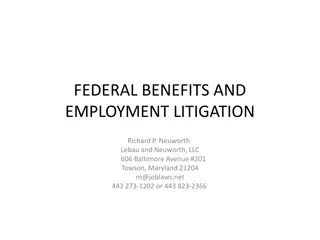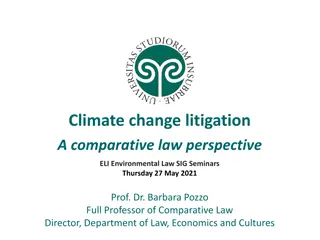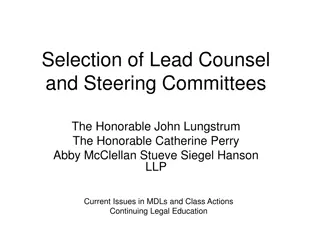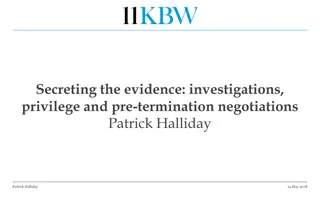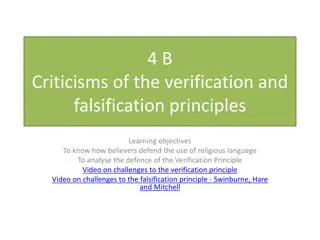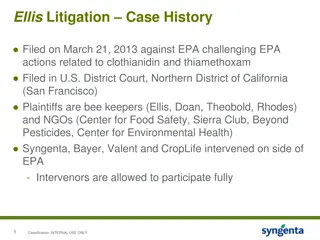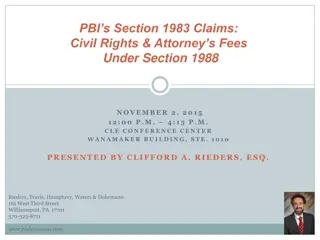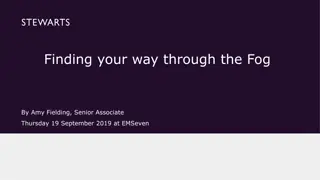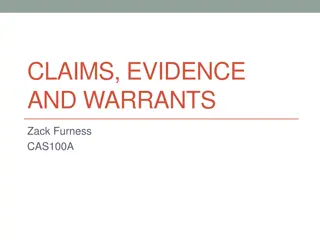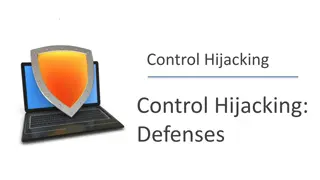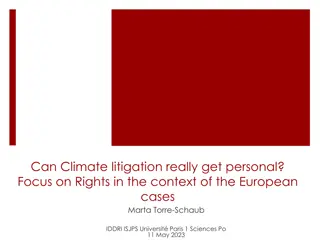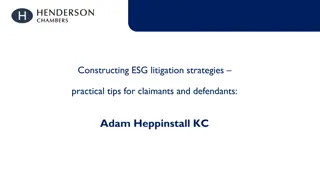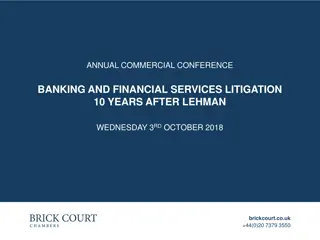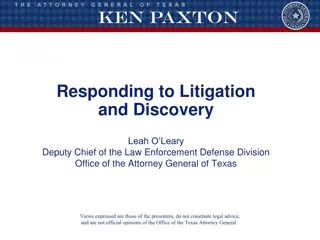Understanding Section 1983 Litigation: Claims, Defenses, and Best Practices
This material delves into the intricacies of Section 1983 litigation, focusing on the implications for law enforcement agencies, typical claims brought under 1983, defense strategies, and best practices to avoid claims. It also explores the dynamics of a vicious cycle perpetuated by media narratives and political influences, further exacerbated by additional drivers like reluctance in charging incidents and propaganda against police interactions.
Download Presentation

Please find below an Image/Link to download the presentation.
The content on the website is provided AS IS for your information and personal use only. It may not be sold, licensed, or shared on other websites without obtaining consent from the author. Download presentation by click this link. If you encounter any issues during the download, it is possible that the publisher has removed the file from their server.
E N D
Presentation Transcript
Fundamentals of Section 1983 Litigation: Claims, Defenses, and Best Practices for Law Enforcement and Corrections Officers Presented by: Randolph T. Barker ABBOTT NICHOLSON, P.C. 1900 W. Big Beaver Road, Suite 203 Troy, MI 48084 (313) 566-2500 Michigan Sheriffs Association 2021 Summer Professional Development Conference
Learning Objectives Overview of 42 USC 1983 and its implications for a law enforcement agency. Discuss the typical claims brought under 1983 and common strategies employed by plaintiff attorneys. Understand defense strategies and best practices to avoid claims.
An Unfortunate Vicious Cycle Extensive and slanted coverage of use-of-force events advance a political narrative that police officers are inherently racist and targeting minorities, such that the police should be feared, avoided, resisted, and defunded. Anti-police, racism, or defund narratives held by the media and political organizations that protest the police intentionally omit key facts and context. In response to this narrative, persons stopped by police are increasingly choosing to flee or resist rather than comply allegedly because they fear serious injury or death if they comply. Compliance is achieved in these situations by uses of force. The cycle repeats where a new incident meets or can be presented in a way that fits the narrative.
Additional Drivers of the Vicious Cycle Reluctance or policy decisions on the part of prosecutors to charge R&O incidents, even with video evidence Injuries to officers and/or bystanders, serves to embolden noncompliance Political organizations propagandizing the inherent dangers of interacting with police and encouraging defiance, aggression, and rioting in response to use-of-force events. According to these organizations, police are not worthy of respect; hostility toward police is a calling, and suffering injury or death at the hands of the police is noble and advances the cause.
42 USC 1983 Every person who, under color of any statute, ordinance, regulation, custom, or usage, of any State or Territory or the District of Columbia, subjects, or causes to be subjected, any citizen of the United States or other person within the jurisdiction thereof to rights, privileges, or immunities secured by the Constitution and laws [of the United States], shall be liable to the party injured in an action at law, suit in equity, or other proper proceeding for redress the deprivation of any
In a Nutshell Persons aggrieved by the conduct of a government actor may bring a lawsuit for deprivation of a constitutional or other federal legal right where the improper conduct is committed under color of law. Suit may be brought in either federal or state court. Claims may be asserted against government actors in their official and/or individual capacities. Does not allow a plaintiff to sue the government or a supervisor on a respondeat superior theory, absent a showing that the supervisor was actually or constructively aware of and allowed/authorized impermissible practices (Iqbal v Ashcroft, 556 U.S. 662, 129 S. Ct. 1937; 173 L. Ed. 2d 868 (2009) Section 1983 is not itself a source of substantive rights, but merely provides a method for vindicating federal rights elsewhere conferred. Albright v. Oliver, 510 U.S. 266, 271, 114 S. Ct. 807, 127 L. Ed. 2d 114 (1994)
Individual vs. Official Capacity Individual Capacity Recovery out of official s pocket Qualified immunity (maybe) Punitive damages available Official capacity Suit is against the governmental entity No qualified immunity No punitive damages
Under Color of Law Under color of law includes misuse of power, possessed by virtue of state law and made possible only because the wrongdoer is clothed with the authority of state law.
Common Constitutional Bases for Claims First Amendment: Freedom of speech, press, assembly, religion, and right to petition. Fourth Amendment: prohibits unreasonable searches and seizures of persons or property. Fifth Amendment: Procedural due process rights; rights of the accused Sixth Amendment: Procedural due process rights/rights of the accused Eighth Amendment: no excessive fines or bail, or cruel and unusual punishments. Each of these amendments apply against the states under the 14thAmendment Substantive due process. Claims against law enforcement officers typically arise under the first, fourth, and eighth amendments. Claims may be asserted even when a person is not arrested.
Common 1983 Claims & Analagous State Law Claims State Law Analogous Claim Constitutional Right Section 1983 Claim Fourth Amendment: claims predicated on arrest, investigatory stop, or other seizure* Assault Battery Excessive Force Unreasonable Search or Seizure Unlawful Arrest False Arrest False Imprisonment Theft/Conversion Cruel and Unusual Punishment Excessive Force** Eighth Amendment: claims by prisoners Assault Battery Fourteenth Amendment: claims by pretrial detainees; claims that fall outside of the Fourth or Eighth Amendment All claims listed above Malicious Prosecution Abuse of Process Negligent Hiring and/or Supervision Deprivations of Liberty Without Due Process of Law Excessive Force***
Sources of Individual Liability Excessive/unnecessary force Failure to intervene or protect Deliberate indifference (including failure to provide necessary medical care) False arrest Malicious prosecution Discrimination claims
Excessive Force: Tennessee v. Garner and Graham v. Connor Force used to detain or effectuate an arrest must be reasonable. Objectively: What level of resistance did the person provide and what level of risk did they pose? Physical characteristics of person (including in relation to the officer). Person s access to or use of weapons (or items that could reasonably be used as a weapon). Time of day. Use of force cannot be gratuitous, malicious, sadistic, or otherwise done with the intention to cause harm. Whitley v. Albers, 475 U.S. 312 (1986); County of Sacramento v. Lewis (S. Ct. 1998). This does not mean the suspect is entitled to a fair fight. A force continuum adopted and followed may permit an officer to respond with the next-highest level of force to gain compliance.
Uses of Force Uses of force should be Applied consistent with an established force continuum that is constitutionally sound. Applied only to the extent reasonable, by a trained officer. Adjusted or terminated when it is or becomes unreasonable or excessive, by the officer applying it and/or through intervention of other officers. Documented on internal use of force forms and all audio/video of the incident retained. Reviewed by use of force investigative teams(UFITs) consisting of senior command/IA personnel.
Excessive Force: Common Disputes Whether detention occurred, and whether its duration and/or manner were reasonable. Resistance? To what extent? Exigent circumstances? Was the force excessive or necessary? Malicious or retaliatory intent of officer(s) Natural reactions to threats or verbal abuse A person s right to resist excessive force
Eighth Amendment: Farmer v. Brennan (S.Ct. 1994) Applies to inmates and pretrial detainees. Untreated prisoner medical issues might give rise to deliberate indifference claims, especially if death results. Failure to protect prisoners from suicide risks, other prisoners, or excessive force employed by other police/corrections officers.
Establishing Local Government Liability: Monell v. NYC Dept of Social Svcs (S.Ct. 1978) Officially-adopted policies But whose policy is it? No written policy prohibiting behavior Customs or practices Failure to train, supervise, discipline, or adequately screen employees upon hire or reinstatement Attributing decisions or acts of a final policymaker to the governmental entity Discrimination claims
Other Claims Involving Police and Corrections Officers First Amendment: interfering with lawful exercise of rights (including the right to subject you to a profanity-laden tirade) Violations of Title VII and ELCRA implicates MDCR jurisdiction (employer and public services) Issues under collective bargaining agreements
Why do Plaintiff Attorneys Accept These Cases? Attorney fees and expert witness fees are recoverable if the plaintiff succeeds on ANY significant issue at trial. 42 USC 1988 Fee Recovery o Common 1/3 contingent fee arrangement Belief that municipalities have deep pockets o Insurance coverage and excess liability policies Belief that negative media coverage of the police and influence of political organizations that protest police will make juries more favorable to plaintiffs Claims asserted under 1983 are generally not dischargeable in bankruptcy.
Plaintiff Strategies: When to File Suit Often filed shortly before the applicable statute of limitations expires Reliance on short record retention policies Faded memories of officers and witnesses Witnesses are more difficult to locate as time passes Plaintiff attorneys are not always predictable and might file almost immediately after the incident, particularly if there is strong evidence of police misconduct Often skip filing a formal complaint with the police department to avoid alerting department of possible claims.
Plaintiff Strategies: Typical Allegations Sensationalize events and embellish injuries. Sue every officer who responded to the scene, in their individual and official capacities, regardless of their involvement or wrongdoing. Claim the municipality is liable for failing to supervise and/or adequately train its police officers. Create impression that officers were amped up and/or had a racial or other discriminatory animus toward the Plaintiff that brought about use of excessive force.
Plaintiff Strategies: Typical Allegations (cont) Assert claims of excessive force, false arrest and improper search and seizure Allege that officers collaborated to prepare a false police report Argue that other officers had a duty, but failed to intervene to protect Plaintiff against excessive force Allege that officers delayed or denied necessary medical care Claims are usually lawyer-driven and often not verified beforehand
Common Flaws with Complaints Conclusory, rather than factual allegations. Bell Atlantic v. Twombly, 127 S. Ct. 1955 (2007). Suit against municipality as a matter of course. Suing the police department. Plaintiff s lack of standing John and Jane Doe Officer defendants Federal vs. analogue state law claims Separate pleading standards (plausibility and notice) Immunity standards for federal and state law claims Preclusion & abstention issues
Plaintiff Strategies: After Filing a Complaint Standard-form discovery requests followed by officer depositions Offer deposition testimony that contradicts that of the officers and other witnesses Avoid defense motions for summary judgment Establish questions of fact for the jury Assert destruction of evidence claims: Audio/video file destruction according to retention policy Adverse inference if intentionally destroyed Establish/embellish injuries related to the incident: Lack of witnesses for emergency room treatment
Defense Strategies: Intake Process Reports, dispatch recordings, dash/body cam and jail audio/video, witness statements Officers personnel and IA files Local residence/business footage Each officer interviewed Command/UFIT interviews Garrity/Gardener interviews Third-party witness interviews Plaintiff s background: CCH, social media, medical records, litigation history, financial information Criminal trial transcripts (or attend, if pending) Possible conflicts of interest among officers
Defense Strategies: Response to Complaint Motion to Dismiss Monell claims against municipality and supervisors Conclusory allegations/more definite statement Abstention Preclusion of claims Qualified and other forms of immunity Statutes of limitation Answer to Complaint Comprehensive response to each allegation/compound allegation Affirmative defenses
Abstention and Preclusion Abstention A federal court may abstain when an issue of state law could be decided in such a way that the federal constitutional issue becomes moot; the federal court awaits outcome of state court ruling on state law issues (Pullman Abstention) Pending state case with state law issues and plaintiff may raise federal claims in that case; typically invoked when the state proceeding is an ongoing criminal case in which the federal plaintiff is the criminal defendant (Younger Abstention) Preclusion Claims raised in the federal court action are inextricably intertwined' with the state court's decision such that the adjudication of the federal claims would undercut the state ruling or require the district court to interpret the application of state laws or procedural rules, then the federal complaint must be dismissed for lack of subject matter jurisdiction (Rooker- Feldman Doctrine) Allegations by convicted Plaintiff that government behavior related to the state court proceedings violated a constitutional right (Heck Doctrine)
Immunity Qualified Immunity federal law construct that applies when a person is sued in their individual capacity. Governmental Immunity Michigan s Governmental Tort Liability Act (GTLA) provides immunity from all tort liability arising from activities where the governmental agency was engaged in the exercise or discharge of a governmental function, [e]xcept as otherwise provided in this act. MCL 691.1407(1). Public Official Immunity - protects individual defendants from tort claims brought against them in their official capacities. Applicability and standards vary based upon level of employee and whether they were engaged in a governmental function.
Defense Strategies: Discovery and Summary Judgment Discovery Medical releases/documentation Witness and exhibit disclosures Motions to compel discovery Deposition of plaintiff before officer depositions (named defendant officers present with municipal designee) Summary Judgment No genuine issues of material fact in dispute Video evidence renders plaintiff s claims implausible Revisits applicable immunity and preclusion doctrines Often a precursor to mediation and case evaluation
Litigation Avoidance & Preparedness Regularly review and update record retention policies and FOIA protocols Expand electronic data retention capabilities Invest in training for officers at all levels. For example: Physical fitness issues Psychological issues Muscle memory Anti-discrimination laws Uses of force/ 1983 claims Communications & professionalism Effective writing Court appearances
Case Studies: JK Suit brought by prominent law firm claimed excessive force, severe injuries, and lost income Investigation revealed that several claims were fabricated Out-of state surveillance countered injury claims One of the officer defendants mishandled the situation and justified nominal settlement
Case Studies D.M. Claimed excessive force against officer trying to help Plaintiff, who was intoxicated and had fallen on thick ice in a driveway. Plaintiff sued the municipality and multiple other officers without basis, resulting in dismissal of those claims A.C. Police were called after Plaintiff threatened a passerby with what appeared to be a handgun (IWB). The handgun turned out to be a 3 knife that had a wooden handle designed to look like a .38 revolver grip, and a sheathe resembling an OWB holster After Plaintiff was secured and placed into the scout car, he had an anxiety attack and claimed his handcuffs were too tight and the car was hot and not ventilated J.H O.C. spray applied as control measure in response to physical resistance and attempting to kick open scout car door Claimed deprivation of medical attention A deposition for the ages
Case Studies: Aldridge v. City of Warren, et al Allegations in Complaint were demonstrably unvetted by counsel and wholly inconsistent with video evidence. The Court granted my motion for summary disposition, finding that Plaintiff s claims were, beyond frivolous Sanctions imposed against Plaintiff s counsel, a self- proclaimed expert in litigating these cases: o Ordered to pay $10,000 in attorney fees, plus costs, to the City; o $2,000 fine imposed by the Court for advancing a frivolous argument concerning my separate ethics issue; o All attorneys at the firm who pursued 1983 cases were required to attend 6 hours of continuing legal education in specified areas of law Plaintiff and his counsel appealed the judgment and award of sanctions to the U.S. Court of Appeals
Aldridge Appeal In a unanimous opinion, the U.S. Court of Appeals: Affirmed entry of summary judgment in favor of the City and the Defendant Officers; Affirmed the award of sanctions against Plaintiff s attorneys; Awarded defense costs on appeal, and, Granted my motion, imposing an additional $1,000 in frivolous appeal sanctions against Plaintiff s attorneys.
Summary The current political climate does not appreciate your dedication and sacrifices in furtherance of ensuring public safety. Plaintiff attorneys are opportunistic. Although this presentation is not all- inclusive, it is critical that your team performs within their Constitutional limitations. Every decision you make is potentially- expensive, even if you are correct. Invest in record retention, ongoing training, and certification enhancements
THANK YOU! Please feel free to drop me a line with any other questions or individual needs! Presented By: Randolph T. Barker, Esq. (313) 566-2500 Email: rtbarker@abbottnicholson.com





